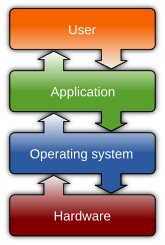
Back Toevoer/afvoer Afrikaans وحدات الإدخال والإخراج Arabic Giriş/çıxış Azerbaijani Вход-изход Bulgarian প্রবিষ্ট/বহির্গত Bengali/Bangla Ulaz/izlaz BS Entrada/sortida Catalan Vstup/výstup Czech I/O Danish Eingabe und Ausgabe German
This article needs additional citations for verification. (November 2019) |
| Operating systems |
|---|
 |
| Common features |
In computing, input/output (I/O, i/o, or informally io or IO) is the communication between an information processing system, such as a computer, and the outside world, possibly a human or another information processing system. Inputs are the signals or data received by the system and outputs are the signals or data sent from it. The term can also be used as part of an action; to "perform I/O" is to perform an input or output operation.
I/O devices are the pieces of hardware used by a human (or other system) to communicate with a computer. For instance, a keyboard or computer mouse is an input device for a computer, while monitors and printers are output devices. Devices for communication between computers, such as modems and network cards, typically perform both input and output operations. Any interaction with the system by an interactor is an input and the reaction the system responds is called the output.
The designation of a device as either input or output depends on perspective. Mice and keyboards take physical movements that the human user outputs and convert them into input signals that a computer can understand; the output from these devices is the computer's input. Similarly, printers and monitors take signals that computers output as input, and they convert these signals into a representation that human users can understand. From the human user's perspective, the process of reading or seeing these representations is receiving output; this type of interaction between computers and humans is studied in the field of human–computer interaction. A further complication is that a device traditionally considered an input device, e.g., card reader, keyboard, may accept control commands to, e.g., select stacker, display keyboard lights, while a device traditionally considered as an output device may provide status data (e.g., low toner, out of paper, paper jam).
In computer architecture, the combination of the CPU and main memory, to which the CPU can read or write directly using individual instructions, is considered the brain of a computer. Any transfer of information to or from the CPU/memory combo, for example by reading data from a disk drive, is considered I/O.[1] The CPU and its supporting circuitry may provide memory-mapped I/O that is used in low-level computer programming, such as in the implementation of device drivers, or may provide access to I/O channels. An I/O algorithm is one designed to exploit locality and perform efficiently when exchanging data with a secondary storage device, such as a disk drive.
- ^ Null, Linda; Julia Lobur (2006). The Essentials of Computer Organization and Architecture. Jones & Bartlett Learning. p. 185. ISBN 0763737690. Archived from the original on 20 December 2016. Retrieved 11 December 2016.